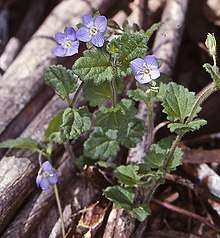Veronica calycina
Veronica calycina, commonly known as hairy- or cup speedwell, is a plant belonging to the family Plantaginaceae native to Australia.[1]
| Veronica calycina | |
|---|---|
 | |
| Veronica calycina flowers & foliage | |
| Scientific classification | |
| Kingdom: | Plantae |
| Clade: | Tracheophytes |
| Clade: | Angiosperms |
| Clade: | Eudicots |
| Clade: | Asterids |
| Order: | Lamiales |
| Family: | Plantaginaceae |
| Genus: | Veronica |
| Species: | V. calycina |
| Binomial name | |
| Veronica calycina | |
Robert Brown described Veronica calycina in 1810 in his work Prodromus Florae Novae Hollandiae et Insulae Van Diemen.[2]
Veronica calycina grows as a perennial herb, with stolons reaching 50 m (2,000 in) in length. The flowering stems can grow 5–45 cm (2–17.5 in) tall. The wide ovate leaves measure around 0.7–3 cm (0.28–1.18 in) long, and 0.5–2 cm (0–1 in) across.[1] The stems are covered with long soft hairs. The small purple flowers occur in groups of 2 to 4 over December and January.[3]
Veronica calycina is found in all states and territories apart from the Northern Territory. It is widely distributed across eastern New South Wales.[1]
References
- B. G. Briggs, B. Wiecek & A. J. Whalen. "New South Wales Flora Online: Veronica calycina". Royal Botanic Gardens & Domain Trust, Sydney, Australia.
- Brown, Robert (1810). Prodromus Florae Novae Hollandiae et Insulae Van Diemen (in Latin). London, United Kingdom: Richard Taylor and Company. p. 435.
- Fairley, Alan; Moore, Philip (2000). Native Plants of the Sydney District: An Identification Guide (2nd ed.). Kenthurst, New South Wales: Kangaroo Press. p. 283. ISBN 0-7318-1031-7.